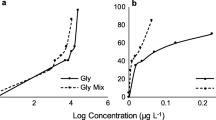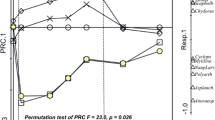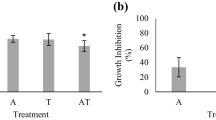Abstract
The ecological risk of pesticides is estimated from data generated on single chemicals. However, agricultural chemicals frequently occur in the environment as herbicide and insecticide mixtures. This study investigated the effects of an herbicide and insecticide mixture in 0.1-ha mesocosms to determine if the herbicide would alter the bioavailability of the insecticide to fish and zooplankton. Mesocosms were treated with either 0 or 50 μg/L atrazine (six mesocosms each) to create two levels of herbicide classification. A series of six concentrations of the pyrethroid insecticide esfenvalerate (0–1.71 μg/L) was applied on two dates within each herbicide level (0 or 50 μg/L). Atrazine altered species composition of macrophytes but did not alter plant biomass, total system metabolism, or the bioavailability of the insecticide to zooplankton or fish. Potential ecological synergisms (i.e., increased effects of the insecticide due to the herbicide) did not occur because of the functional redundancy of the macrophyte community and the rapid aqueous dissipation rate of the pyrethroid insecticide.
Similar content being viewed by others
References
Anderson RL (1989) Toxicity of synthetic pyrethroids to freshwater invertebrates. Environ Toxicol Chem 8:403–410
Bedford B (1984) The role of ecosystem science in USEPA's mission to regulate toxic substances. Environ Manage 8:377–383
Cairns J Jr (1983) Are single species toxicity tests alone adequate for estimating environmental hazard? Hydrobiologia 100:47–57
Cairns J Jr, Dickson KL (1977) Elasticity, inertia, and resiliency of water ecosystems. In Soltero R (ed) Proceedings of the symposium on terrestrial and aquatic ecological studies of the Northwest. EWCS Press, Cheney, WA
Carney EC (1983) The effects of atrazine and grass carp on freshwater macrophyte communities. M.S. Thesis, University of Kansas, Lawrence
Carpenter SR, Lodge DM (1986) Effects of submersed macrophytes on ecosystem processes. Aquat Bot 26:341–370
Clark JR, Goodman LR, Borthwick PW, Patrick JM, Cripe GM, Moody PM, Moore JC, Lores EM (1989) Toxicity of pyrethroids to marine invertebrates and fish: A literature review and test results with sediment-sorbed chemicals. Environ Toxicol Chem 8:393–401
Coats JR, Bradbury SP (1989) Aquatic toxicology of synthetic pyrethroid insecticides. Environ Toxicol Chem 8:359
Coats JR, Symonik DM, Bradbury SP, Dyer SD, Timson LK, Atchison GJ (1989) Toxicology of synthetic pyrethroids in aquatic organisms: An overview. Environ Toxicol Chem 8:671–680
Correll DL, Wu TL (1982) Atrazine toxicity to submersed vascular plants in simulated estuarine microcosms. Aquat Bot 14:151–158
Crossey MJ, La Point TW (1988) A comparison of periphyton community structural and functional responses to metals. Hydrobiologia 162:109–121
DeNoyelles F, Kettle WD, Sinn DE (1982) The responses of plankton communities in experimental ponds to atrazine, the most heavily used pesticide in the United States. Ecology 63:1285–1293
Engle S (1985) Aquatic community interactions of submerged macrophytes. Tech Bull No. 156, Department of Natural Resources, Madison, WI
Fairchild JF, Boyle T, English WR, Rabeni C (1987) Effects of sediment and contaminated sediment on structural and functional components of experimental stream ecosystems. Water Air Soil Pollut 36:271–229
Fairchild JF, La Point TW, Zajicek JL, Nelson MK, Dwyer FJ, Lovely PA (1992) Population, community, and ecosystem-level responses of aquatic mesocosms to pulsed doses of a pyrethroid insecticide. Environ Toxicol Chem 12:115–129
Farm Chemicals Handbook (1993) Farm chemicals handbook. Meister Publishing, Willoughby, OH
Frank S, Sirons GJ (1979) Atrazine: Its use in corn production and its loss to stream waters in Southern Ontario, 1975–1977. Sci Total Environ 12:223–239
Glenn S, Angle JS (1987) Atrazine and simazine in runoff from conventional and no-till corn watersheds. Agric Ecosyst Environ 18:273–280
Hall JK (1974) Erosional losses of s-triazine herbicides. J Environ Qual 3:174–180
Haya K (1989) Toxicity of pyrethroid insecticides to fish. Environ Toxicol Chem 8:381–391
Heinis LJ, Knuth ML (1992) The mixing distribution and persistence of esfenvalerate within littoral enclosures. Environ Toxicol Chem 11:11–25
Hersh CM, Crumpton WG (1989) Atrazine tolerance of algae isolated from two agricultural streams. Environ Toxicol Chem 8:327–332
Hoagland KD, Drenner RW, Smith JD, Cross DR (1993) Freshwater community responses to mixtures of agricultural pesticides: Effects of atrazine and bifenthrin. Environ Toxicol Chem 12:627–637
Junk GA, Spalding RF, Richards JJ (1980) Areal, vertical, and temporal differences in ground water chemistry. II. Organic constituents. J Environ Qual 9:479–482
Kemp WM, Boynton WR, Cunningham JJ, Stevenson JC, Jones TW, Means JC (1985) Effects of atrazine and linuron on photosynthesis and growth of the macrophytes, Potomogeton perfoliatus L. and Myriophyllum spicatum L. in an estuarine environment. Mar Environ Res 16:255–280
Kimball KD, Levin SA (1985) Limitations of laboratory bioassays: The need for ecosystem-level testing. BioScience 35(3):165–171
Klaine SJ, Hinman ML, Winkelmann DA, Sauser KR, Martin JR, Moore LW (1988) Characterization of agricultural nonpoint pollution: Pesticide migration in a West Tennessee Watershed. Environ Toxicol Chem 7:609–6142
Larsen DP, DeNoyelles F, Stay F, Shiroyama T (1986) Comparisons of single-species, microcosm, and experimental pond responses to atrazine exposure. Environ Toxicol Chem 5:179–190
Macek KJ, Buxton KS, Sauter S, Gnilka S, Dean JW (1976) Chronic toxicity of atrazine to selected aquatic and invertebrates and fishes. EPA 600/3–76–047, Ecological Research Series Report, U.S. Environmental Protection Agency, Office of Research and Development, Environmental Research Laboratory, Duluth, MN
Marking LL (1985) Toxicity of chemical mixtures. In Rand GM, Petrocelli SR (eds) Fundamentals of aquatic toxicology: Methods and applications. Hemisphere Publishing Co, NY, pp 164–176
McCarthy JF, Bartell SM (1988) How the trophic status of a community can alter the bioavailability and toxic effects of contaminants. In Cairns J Jr, Pratt JR (eds) Functional testing of aquatic biota for estimating the hazards of chemicals, ASTM STP 988. American Society for Testing and Materials, Philadelphia, PA, pp 3–16
Moreland DE (1980) Mechanisms of action of herbicides. Annu Rev Plant Physiol 31:597–638
Pratt JR, Bowers NJ, Niederlehner BR, Cairns J (1988) Effects of atrazine on freshwater microbial communities. Arch Environ Contam Toxicol 17:449–457
Pratt JR, Rosenberger JL (1993) Community change and ecosystem functional complexity: A microcosm study of copper toxicity. In Gorsuch JW, Dwyer FJ, Ingersoll CG, La Point TW (eds) Environmental toxicology and risk assessment, 2nd vol, ASTM STP 1216. American Society for Testing and Materials, Philadelphia, PA, pp 88–102
Richard JJ, Junk GA, Avery MJ, Nehring NL, Fritz JS, Svec HJ (1975) Analysis of various Iowa waters for selected pesticides: Atrazine, DDE, and dieldrin-1974. Pest Monit J 9:117–123
Robinson-Wilson EF, Boyle TP, Petty JD (1983) Effects of increasing levels of primary production on pentachlorophenol residues in experimental pond ecosystems. In Bishop WE, Cardwell RD, Heidolph BB (eds) Aquatic toxicology and hazard assessment: Sixth symposium, ASTM STP 802. American Society for Testing and Materials, Philadelphia, PA, pp 239–251
Schindler DW, Mills KH, Malley DF, Findlay DL, Shearer JA, Davies IJ, Turner MA, Linsey GA, Cruikshank DR (1985) Long-term ecosystem stress: The effects of years of experimental acidification on a small lake. Science 228:1395–1401
Touart LW (1988) Aquatic mesocosm tests to support pesticide registrations, EPA 540/09–28–0. U.S. Environmental Protection Agency, Washington, DC
Triplett JR, Conner BJ, Edwards WM (1978) Transport of atrazine and simazine in runoff from conventional and no-tillage corn. J Environ Qual 7:77–84
Urban DJ, Cook NJ (1986) Hazard Evaluation Division, standard evaluation procedure, ecological risk assessment, EPA 540/9–85–001. U.S. Environmental Protection Agency, Washington, DC
Walker BH (1992) Biodiversity and ecological redundancy. Conserv Biol 6:18–23
Wauchope RD (1988) Interim pesticide properties data base, version 1.0. USDA/ARS, Washington, DC
Wetzel RG (1975) Limnology. WB Saunders Co, Philadelphia, PA
Author information
Authors and Affiliations
Rights and permissions
About this article
Cite this article
Fairchild, J.F., La Point, T.W. & Schwartz, T.R. Effects of an herbicide and insecticide mixture in aquatic mesocosms. Arch. Environ. Contam. Toxicol. 27, 527–533 (1994). https://doi.org/10.1007/BF00214845
Received:
Revised:
Issue Date:
DOI: https://doi.org/10.1007/BF00214845




